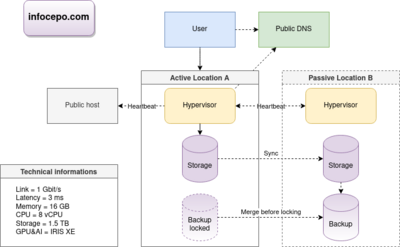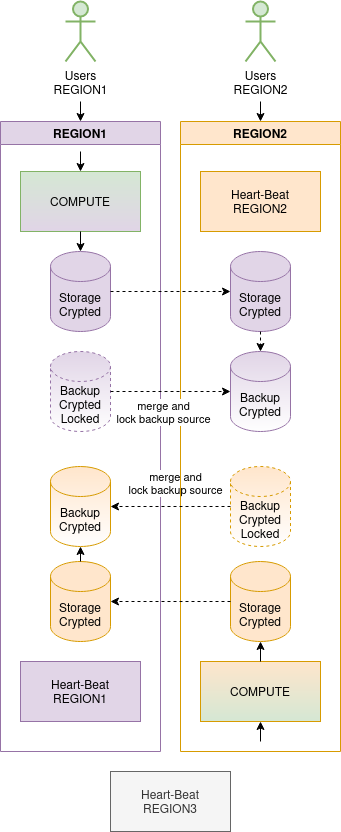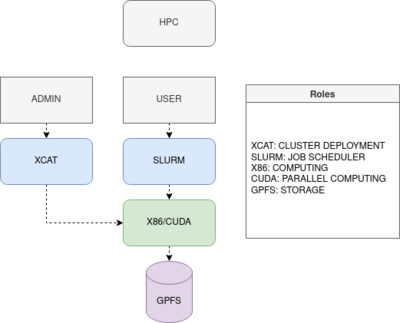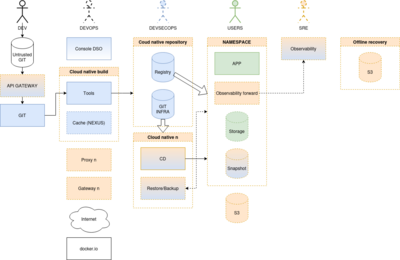Main Page
infocepo.com – Cloud, IA & Labs
Bienvenue sur le portail infocepo.com.
Ce wiki s’adresse aux administrateurs système, ingénieurs cloud, développeurs, étudiants et passionnés qui veulent :
- Comprendre les architectures modernes (Kubernetes, OpenStack, bare-metal, HPC…)
- Mettre en place des assistants IA privés et des outils de productivité
- Construire des labs concrets pour apprendre en pratiquant
- Préparer des audits, migrations et automatisations à grande échelle
L’objectif : transformer la théorie en scripts, diagrammes et architectures réutilisables.
Démarrer rapidement
Parcours recommandés
- 1. Monter un assistant IA privé
- Déployer un stack type : Open WebUI + Ollama + GPU (H100 ou GPU grand public)
- Ajouter un modèle de chat + un modèle de résumé
- Intégrer des données internes (RAG, embeddings)
- 2. Lancer un lab Cloud
- Créer un petit cluster (Kubernetes, OpenStack ou bare-metal)
- Mettre en place un pipeline de déploiement (Helm, Ansible, Terraform…)
- Ajouter un service IA (transcription, résumé, chatbot…)
- 3. Préparer un audit/migration
- Inventorier les serveurs avec ServerDiff.sh
- Dessiner l’architecture cible (diagrammes cloud)
- Automatiser la migration avec des scripts reproductibles
Résumé des contenus
- Guides & outils IA : assistants, modèles, évaluations, GPU
- Cloud & infra : HA, HPC, web-scale, DevSecOps
- Labs & scripts : audit, migration, automation
- Tableaux comparatifs : Kubernetes vs OpenStack vs AWS vs bare-metal, etc.
futur
Assistants IA & Outils Cloud
Assistants IA
- ChatGPT
- ChatGPT – Assistant conversationnel public, adapté à l’exploration, à la rédaction et à l’expérimentation rapide.
- Assistants IA auto-hébergés
- Open WebUI + GPU H100 + Ollama
- Stack type pour assistants privés, LLMs auto-hébergés et API compatibles OpenAI.
- Private summary – Résumeur local, rapide et hors-ligne pour vos propres données.
Développement, modèles & suivi
- Découvrir et suivre les modèles
- LLM Trending – Bibliothèque de modèles (chat, code, RAG…) pour déploiement local.
- Models Trending – Marketplace de modèles, filtrage par tâche, taille, licence.
- Img2txt Trending – Modèles vision-langage (image → texte).
- Txt2img Evaluation – Comparaison de modèles de génération d’images.
- Évaluation & benchmarks
- ChatBot Evaluation – Classement de chatbots (modèles open-source et propriétaires).
- Embedding Leaderboard – Benchmark des modèles d’embedding pour RAG et recherche sémantique.
- Vectors DB Ranking – Comparatif de bases vectorielles (latence, mémoire, fonctionnalités).
- HPC Efficiency – Classement des supercalculateurs les plus efficaces énergétiquement.
- Outils de développement & fine-tuning
- Project Trending – Grands projets open source récents, triés par popularité et activité.
- LLM Fine Tuning – Framework avancé pour fine-tuning de LLMs (instruction-tuning, LoRA, etc.).
- Perplexity AI – Recherche avancée et synthèse orientée “copilote de recherche”.
Matériel IA & GPU
- GPU & accélérateurs
- NVIDIA H100 – GPU datacenter pour clusters Kubernetes et workloads IA intensifs.
- NVIDIA 5080 – GPU grand public pour déploiements privés de LLMs à moindre coût.
- GROQ LLM accelerator – Accélérateur matériel dédié à l’inférence LLM.
Modèles ouverts & Endpoints internes
(Dernière mise à jour : 08/12/2025)
Les modèles ci-dessous correspondent à des endpoints logiques (par exemple via un proxy ou une gateway), choisis pour des usages précis.
| Endpoint | Description / Cas d’usage principal |
|---|---|
| ai-chat | Basé sur gpt-oss-20b – Chat généraliste, bon compromis coût / qualité. |
| ai-translate | gpt-oss-20b, température = 0 – Traduction déterministe, reproductible (FR, EN, autres langues). |
| ai-summary | qwen3 – Modèle optimisé pour la synthèse de textes longs (rapports, docs, transcriptions). |
| ai-code | gpt-oss-20b – Raisonnement sur le code, explication et refactorisation. |
| ai-code-completion | granite-2b – Complétion de code rapide, pensée pour l’auto-complétion IDE. |
| ai-parse | gemma2-simpo – Extraction structurée, parsing de logs / JSON / tableaux. |
| ai-RAG-FR | qwen3 – Usage RAG en français (connaissance métier, FAQ internes). |
| gpt-oss-20b | Tâches agentiques. |
Idée d’usage : chaque endpoint est associé à un ou plusieurs labs (chat, résumé, parsing, RAG, etc.) dans la section Cloud Lab.
Actualités & Tendances
- Top AI News – Sélection vidéo des actus IA.
- Real-time transcription with Diart + Whisper – Exemple de transcription temps réel avec détection de locuteurs.
- OpenAI Translator – Extension / client moderne pour traduction assistée par LLM.
- Opensearch with LLM – Recherche conversationnelle basée sur LLMs et OpenSearch.
Formation & Apprentissage
- Transformers Explained – Introduction aux Transformers, architecture clé des LLMs.
- Labs, scripts et retours d’expérience concrets dans le projet CLOUD LAB ci-dessous.
Cloud Lab & Projets d’Audit
Le Cloud Lab propose des scénarios reproductibles : audit d’infrastructure, migration vers le cloud, automatisation, haute disponibilité.
Projet d’audit – Cloud Audit
Script Bash d’audit de serveurs pour :
- détecter les dérives de configuration,
- comparer plusieurs environnements,
- préparer une migration ou un plan de remédiation.
Exemple de migration Cloud
Exemple : migration d’environnements virtuels vers un cloud modernisé, avec audit, design d’architecture et automatisation.
| Tâche | Description | Durée (jours) |
|---|---|---|
| Audit de l’infrastructure | 82 services, audit automatisé via ServerDiff.sh | 1,5 |
| Diagramme d’architecture cloud | Conception et documentation visuelle | 1,5 |
| Contrôle de conformité | 2 clouds, 6 hyperviseurs, 6 To de RAM | 1,5 |
| Installation des plateformes cloud | Déploiement des environnements cibles principaux | 1,0 |
| Vérification de stabilité | Tests de fonctionnement précoce | 0,5 |
| Étude d’automatisation | Identification et automatisation des tâches répétitives | 1,5 |
| Développement de templates | 6 templates, 8 environnements, 2 clouds / OS | 1,5 |
| Diagramme de migration | Illustration du processus de migration | 1,0 |
| Écriture du code de migration | 138 lignes (voir MigrationApp.sh) | 1,5 |
| Stabilisation du process | Validation que la migration est reproductible | 1,5 |
| Benchmarking cloud | Comparaison de performance vs infrastructure legacy | 1,5 |
| Calage du downtime | Calcul du temps de coupure par migration | 0,5 |
| Chargement des VMs | 82 VMs : OS, code, 2 IP par VM | 0,1 |
| Total | 15 jours·homme | |
Vérification de stabilité (HA minimale)
| Action | Résultat attendu |
|---|---|
| Extinction d’un nœud | Tous les services doivent redémarrer automatiquement sur les nœuds restants. |
| Extinction / rallumage simultané de tous les nœuds | Tous les services doivent remonter correctement après redémarrage. |
Architecture Web & Bonnes Pratiques
Principes pour concevoir des architectures web scalables et portables :
- Favoriser une infrastructure simple, modulaire et flexible.
- Suivre la localisation des clients (GDNS ou équivalent) pour rapprocher les contenus.
- Utiliser des load balancers réseau (LVS, IPVS) pour la montée en charge.
- Comparer systématiquement les coûts, et se méfier du vendor lock-in.
- TLS :
- HAProxy pour les frontends rapides,
- Envoy pour la compatibilité et les cas avancés (mTLS, HTTP/2/3).
- Cache :
- Varnish, Apache Traffic Server pour les gros volumes de contenu.
- Privilégier les stacks open source et les caches de base de données (ex. Memcached).
- Utiliser des files de messages, buffers et quotas pour lisser les pics de charge.
- Pour des architectures complètes :
Comparatif des grandes plateformes Cloud
| Fonction | Kubernetes | OpenStack | AWS | Bare-metal | HPC | CRM | oVirt |
|---|---|---|---|---|---|---|---|
| Outils de déploiement | Helm, YAML, ArgoCD, Juju | Ansible, Terraform, Juju | CloudFormation, Terraform, Juju | Ansible, Shell | xCAT, Clush | Ansible, Shell | Ansible, Python |
| Méthode de bootstrap | API | API, PXE | API | PXE, IPMI | PXE, IPMI | PXE, IPMI | PXE, API |
| Contrôle des routeurs | Kube-router | API Routeur/Sous-réseau | Route Table / Subnet API | Linux, OVS | xCAT | Linux | API |
| Contrôle du pare-feu | Istio, NetworkPolicy | Security Groups API | Security Group API | Pare-feu Linux | Pare-feu Linux | Pare-feu Linux | API |
| Virtualisation réseau | VLAN, VxLAN, autres | VPC | VPC | OVS, Linux | xCAT | Linux | API |
| DNS | CoreDNS | DNS-Nameserver | Route 53 | GDNS | xCAT | Linux | API |
| Load Balancer | Kube-proxy, LVS | LVS | Network Load Balancer | LVS | SLURM | Ldirectord | N/A |
| Options de stockage | Local, Cloud, PVC | Swift, Cinder, Nova | S3, EFS, EBS, FSx | Swift, XFS, EXT4, RAID10 | GPFS | SAN | NFS, SAN |
Ce tableau sert de point de départ pour choisir la bonne pile selon :
- Niveau de contrôle souhaité (API vs bare-metal),
- Contexte (on-prem, cloud public, HPC, CRM…),
- Outillage d’automatisation déjà en place.
Liens utiles Cloud & IT
- Cloud Providers Compared – Correspondance des services AWS / Azure / GCP.
- Global Internet Topology Map – Cartographie globale de l’Internet.
- CNCF Official Landscape – Panorama des projets cloud-native (CNCF).
- Wikimedia Cloud Wiki – Infrastructure Wikimedia, exemple réel à grande échelle.
- OpenAPM – SRE Tools – Outillage APM / observabilité.
- RedHat Package Browser – Recherche de paquets et versions chez Red Hat.
- Baromètre TJM Freelance IT – Référentiel de tarifs freelances.
- IT Salaries (Glassdoor) – Indications de salaires IT.
Avancé : Haute Disponibilité, HPC & DevSecOps
Haute Disponibilité avec Corosync & Pacemaker
Principes de base :
- Clusters multi-nœuds ou bi-sites pour la redondance.
- Utilisation d’IPMI pour le fencing, provisioning via PXE/NTP/DNS/TFTP.
- Pour un cluster 2 nœuds :
– séquencer le fencing pour éviter les split-brains, – 3 nœuds ou plus restent recommandés pour la production.
Pattern de ressources courant
- Stockage multipath, LUN, LVM, NFS.
- Ressources utilisateurs et processus applicatifs.
- IP virtuelle, enregistrements DNS, listeners réseau.
HPC
- Orchestration de jobs (SLURM ou équivalent).
- Partage de stockage haute performance (GPFS, Lustre…).
- Intégration possible avec des workloads IA (entraînement massif, inference sur GPU).
DevSecOps
- Pipelines CI/CD avec contrôles de sécurité intégrés (linting, SAST, DAST, SBOM).
- Observabilité (logs, metrics, traces) intégrée dès la conception.
- Automatisation des scans de vulnérabilités, gestion des secrets, policy-as-code.
À propos & Contributions
Pour plus d’exemples, de scripts, de diagrammes et de retours d’expérience, consulter :
Les suggestions de correction, d’amélioration de diagrammes, ou de nouveaux labs sont les bienvenues. Ce wiki a vocation à rester un laboratoire vivant pour l’IA, le cloud et l’automatisation.







